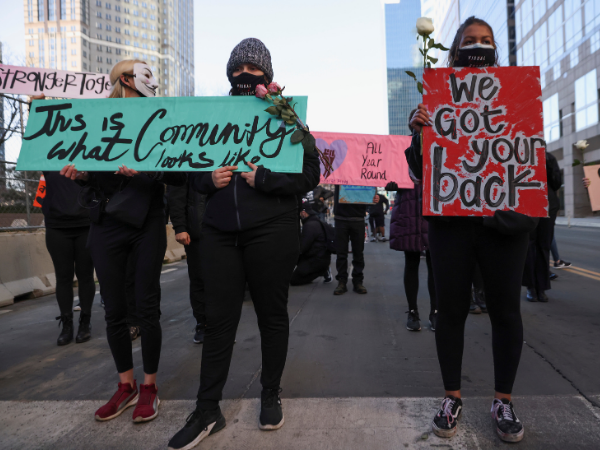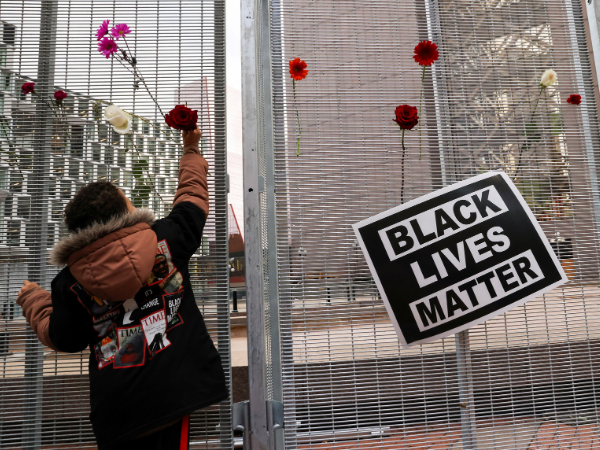Minneapolis trial in George Floyd death starts
The trial of former Minneapolis police officer Derek Chauvin for the death of George Floyd was due to begin on Monday with the screening of jurors to weigh murder and manslaughter charges in a case seen as a referendum on police violence against Black Americans.
The judge has set aside three weeks for jury selection alone, mindful of the difficulties finding impartial Minneapolitans in a case that has convulsed a nation and in which an image of the victim — a selfie of Floyd faintly smiling — has become an international icon of racial justice.

People hold signs as they gather outside of the Hennepin County Government Center on the first day of the trial of former Minneapolis police officer Derek Chauvin, on murder charges in the death of George Floyd in Minneapolis, Minnesota, U.S., March 8, 2021. REUTERS/Leah Millis
The court mailed prospective jurors an unusually detailed 16-page questionnaire last year asking them what they know about Floyd’s death on May 25 on the street after his arrest outside a Minneapolis grocery store.
Among the questions: Have they seen video of his death? Recorded on bystanders’ cellphones and police body-worn cameras, they show Chauvin, who is white, with his knee on Floyd’s neck for nearly nine minutes as Floyd, a 46-year-old Black man in handcuffs, pleads for his life before fading into stillness.
Have they taken part in the protests that followed? Video of Floyd’s dying words — “I can’t breathe” — spread online within hours, causing one of the largest protest movements ever seen in the United States, with daily marches in cities around the country decrying police brutality and racism.
And what do they think of Black Lives Matter? Chauvin’s lawyers are expected to challenge the seating of jurors who show support for the movement against racism in the justice system.
Chauvin’s lawyers have up to 15 peremptory challenges by which they can exclude a juror without having to cite a reason, while the prosecutors from the Minnesota attorney general’s office have nine. If one side suspects the other is challenging a juror on the basis of race, ethnicity or sex, it can ask the judge to overrule.
Jurors in Floyd Case

A child places a flower on a fence near a “Black Lives Matter” placard during a rally the day before jury selection is scheduled to begin for the trial of former Minneapolis policeman Derek Chauvin, who is accused of killing George Floyd, in Minneapolis, Minnesota, U.S. March 7, 2021. REUTERS/Leah Millis
Some criminal justice experts fear the resulting 12 jurors and four alternates may not include any Black people and that this could undermine public perception of the validity of any eventual verdict.
“In an ideal world you want somebody who hasn’t formed an opinion,” Aviva Orenstein, a law professor at Indiana University Maurer School, said in an interview. “Do you know a Black person who has not formed an opinion about George Floyd?”
About a fifth of Minneapolis residents are Black.
“What all of us should be wanting is a jury that represents the range of views and opinions and demographic characteristics of the community,” Valerie Hans, a law professor at Cornell University who studies the jury system, said in an interview. “That should include people that maybe were in protests and have a variety of views on the related issues.”
Chauvin, 44, is charged with second-degree murder, which carries a sentence of up to 40 years in prison, and manslaughter. On Friday, the Minnesota Court of Appeals ordered the lower court to reconsider prosecutors’ request to also reinstate a third charge, third-degree murder. It was unclear whether that order might delay proceedings.
Chauvin was released from jail on a $1 million bond last October and will be tried in a courtroom in the Hennepin County Government Center, a tower in downtown Minneapolis now ringed with fencing and concrete barricades for fear of disruption by protesters.
He appeared in court dressed in a navy blue suit and tie, a white shirt and a black face mask and jotted notes in a yellow legal pad on the table before him.
Chauvin’s lead lawyer, Eric Nelson, told the court the defense would appeal the Friday ruling, while prosecutors argued that the district court did not have jurisdiction while outstanding legal issues were resolved.
Small groups of protesters gathered by the barricades at an adjoining park, some arriving with bouquets of flowers and signs daubed with optimistic slogans: “A change is coming.” A few volunteers set up tables, handing out donated coffee and donuts.
The courtroom has been adapted to mitigate the spread of the novel coronavirus, and Judge Peter Cahill has sharply limited attendance inside: the families of Chauvin and Floyd have each been allocated a single seat inside the courtroom, and most reporters attending must watch a video stream in a building across the street.
Lawyers for Chauvin, who was fired from the police force the day after Floyd’s death, have argued that he correctly followed his training in helping colleagues arrest Floyd on suspicion of using a counterfeit $20 bill at the Cup Foods grocery store. A handcuffed Floyd can be seen in videos struggling against being placed in a police vehicle complaining he has claustrophobia.
The medical examiner ruled that Floyd’s death was a homicide caused partly by police restraint holds. But the autopsy report also noted that Floyd had recently ingested the opioid fentanyl, and Chauvin’s lawyers contend that an overdose was the main cause of death.
(Reporting by Jonathan Allen in Minneapolis; Editing by Daniel Wallis and Steve Orlofsky)

